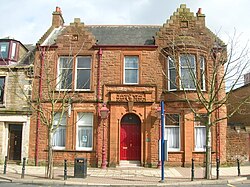
Irvine is an ancient settlement, in medieval times a royal burgh, and now a new town on the coast of the Firth of Clyde in North Ayrshire, Scotland. The 2011 Census recorded the town's population at 33,698 inhabitants, making it the largest settlement in North Ayrshire.
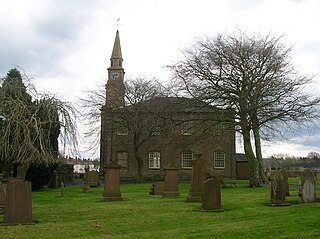
Tarbolton is a village in South Ayrshire, Scotland. It is near Failford, Mauchline, Ayr, and Kilmarnock. The old Fail Monastery was nearby and Robert Burns connections are strong, including the Bachelors' Club museum.

During the years 1781–1782, at the age of 23, Robert Burns (1759–1796) lived in Irvine, North Ayrshire for a period of around 9 months, whilst learning the craft of flax-dressing from Alexander Peacock, who may have been his mother's half-brother, working at the heckling shop in the Glasgow Vennel. Dr John Cumming of Milgarholm, a provost of Irvine, claimed that he had invited Burns to come to Irvine to learn flax dressing. During this time he made a number of acquaintances, befriended several locals and took regular walks into the Eglinton Woods via the old Irvine to Kilwinning toll road and the Drukken or Drucken (Drunken) Steps. Steps over the Red Burn and back via the site of Saint Brides or Bryde's Well at Stanecastle. Burns had several other connections with the Eglinton Estate and other branches of the Montgomerie family. He probably left in March 1782.

The Drukken, Drucken Steps or Drunken Steps were stepping stones across the Red Burn in Irvine, North Ayrshire, Scotland and are associated with Scotland's national poet, Robert Burns. Drukken is used on the commemorative cairn plaque, but Druken or Drucken may also be used.
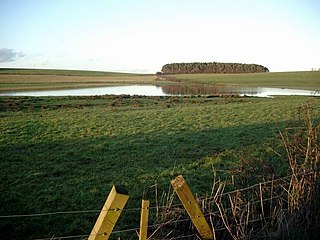
Lochlea or Lochlie was situated in a low-lying area between the farms and dwellings of Lochlea and Lochside in the Parish of Tarbolton, South Ayrshire, Scotland. The loch was natural, sitting in a hollow created by glaciation. The loch waters ultimately drained via Fail Loch, the Mill Burn, and the Water of Fail. It is well-documented due to the presence of a crannog that was excavated and documented circa 1878, and its association with the poet Robert Burns, who lived here for several years whilst his father was the tenant. Lochlea lies 2+1⁄2 miles northeast of Tarbolton, and just over three miles northwest of Mauchline.

John MacKenzie (c.1755–1837) was a Scottish army surgeon. He was a native of Ayrshire, where he married Helen Miller (d.1827), one of the "Six proper Mauchline belles" who is buried in Irvine's Old Parish church. He was a member with Robert Burns of the St James Lodge, Tarbolton. His house in Mauchline is now the 'Burns House Museum,' run by East Ayrshire Council. MacKenzie wrote "Origin of Morals and Common Sense."

Richard Brown or Ritchie Broun in Scots was born in Irvine. He was a sea captain and a one time friend of Robert Burns who is credited by Burns as the being the person who "encouraged me to endeavour at the character of a Poet."

Gilbert Burns, the younger brother of Robert Burns the poet, was born at Alloway. He married Jean Breckenridge in 1791, had 6 sons and 5 daughters, died in 1827, aged 66, and was buried at Bolton, East Lothian, Scotland. Gilbert's writings have contributed greatly to the bank of knowledge that exists regarding the life of his famous brother.

David Sillar (1760–1830) was a Scottish farmer, poet, grocer, schoolteacher and baillie who was a close friend of the poet Robert Burns. He died in 1830, aged 70, after a long illness, and was buried in Irvine's Old Parish Church cemetery. His eroded gravestone was replaced by a facsimile thanks to the Irvine Burns Club. He married twice and had only one son survive him, a Dr. Zachary Sillar M.D. of Liverpool. His father was Patrick Sillar, tenant farmer at Spittalside near Tarbolton, Ayrshire. He first married a widow, Mrs Margaret Kerr, née Gemmell shortly after moving to Irvine and had seven children and his second wife was the sister of John Bryan of the Sun Inn, Kilmarnock.

Coila was the muse of Robert Burns who created her as a poetic device for his poem The Vision in which she provides inspiration and encouragement. The University of the West of Scotland have erected a statue to Coila in recognition of her role in providing inspiration and encouragement to others.
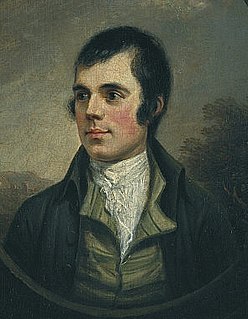
Burns Clubs exist throughout the world to encourage and cherish the memory of Robert Burns, to foster a love of his writings and generally to encourage an interest in the Scots Language and Literature. An emphasis on encouraging the young to take an interest in Burns is found in most clubs through poetry, singing and other competitions. Once mainly existing as 'male only' clubs in the mould of the Tarbolton 'Batchelor's Club' most now welcome women as fellow members. Ladies Burns Clubs also exist such as the 'Irvine Lasses' that was established in 1975; it has appointed several male 'Honorary Lasses'.

The Robert Burns World Federation is a literary society based in Kilmarnock, Ayrshire, Scotland, aimed at educating the public about the life, poetry and works of the poet Robert Burns. It is a Scottish Charity and a company limited by Guarantee. The Federation links existing Burns Clubs and similar groups, giving a unique number to affiliated Clubs, which is then used by them in their promotion and identification. Their ongoing intent is to provide a way for clubs to link together and enjoy the mutual benefit of association, communication and shared mission. It was founded in 1885
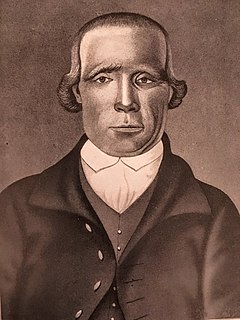
John Goldie, Goudie or Gowdie (1717–1811) the 'Philosopher' was a friend of the poet Robert Burns who was born the son of a miller at Craigmill on the Cessnock Water in East Ayrshire, Scotland. He was a miller, mechanic, cabinet maker, later a wine merchant and had interests ranging from the study of mathematics and astronomy to that of theology, publishing several books, in particular in 1780 the popular three volume Essays on various Important Subjects Moral and Divine, being an attempt to distinguish True from False Religion, a publication that became generally known as 'Goudie's Bible' and raised him to national prominence. The name John Goldie will be used throughout for consistency.

Fog Houses are a special type of pleasure or summer house popular in Scotland and at one time commonly found on many country estates as a feature in the pleasure gardens. The name 'Fog' derives from the Scots word for the moss that was a major feature of the building, mainly used to line the walls and roof.

Kate Kemp of Barskimming lived with her father at the Bridge House on the northern side of the single span Barskimming Old Bridge, River Ayr, Scotland. Both Robert Burns and James Andrew, the miller at Barskimming Mill, had a romantic interest in her and one visit led to the composition of the poem and dirge "Man was made to Mourn".
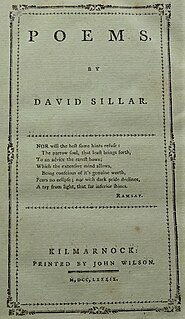
Poems is a collection of poetry and songs by David Sillar, a close friend of the poet Robert Burns who had been encouraged to go into print by the success of Poems, Chiefly in the Scottish Dialect. Poems was printed by John Wilson of Kilmarnock in 1789. Sillar's interest in poetry predated his friendship with Burns, but was one of several reasons for it.
Alexander Tait, Sawney Tait or Saunders Tait was a tailor, a published poet and also a contemporary of Robert Burns who he knew well. Tait was also well acquainted with the published poet and close friend of Burns, David Sillar. Sawney spent much of his life in Tarbolton where he was an active member of the community. His poems were exhibited in the 1896 Burn Exhibition, a copy being loaned by the Mitchell Library. Alexander was generally known locally as 'Whip-the-cat' an old expression that referred to itinerant tailors, etc. who went from door to door to do work for others.

Gavin Hamilton was one of Robert Burns's closest friends and a patron. The first 'Kilmarnock Edition' of his poems were dedicated to Gavin Hamilton.

John Richmond (1765–1846) was one of Robert Burns's closest friends and confidants. He was born in Sorn parish at Montgarswood, Ayrshire, Scotland. His father, Henry Richmond, was a merchant in Mauchline and owned Montgarswood Farm that lies near Sorn. This farm passed to James, John's brother, having once been farmed by William Fisher, Burns's Holy Willie.

James Smith of Mauchline was one of Robert Burns's closest friends and confidants. He was born in 1765, son of a Mauchline merchant, Ayrshire, Scotland. In 1775, when he was only ten years, old his father, Robert Smith, a prosperous local merchant, was killed in a riding accident, falling from his horse whilst returning from Ayr. His mother, Jean Smith, remarried James Lamie who owned the adjoining house.
